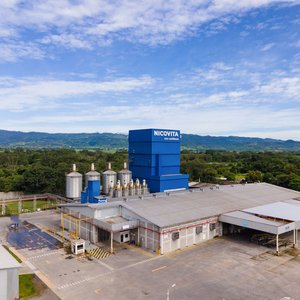Short-chain fatty acids (SCFA), including butyrate and its derived forms such as sodium butyrate, have been used as dietary supplements to reverse or ameliorate the potential negative effects of plant-derived ingredients in aquaculture diets, and have a multitude of physiological- and health-enhancing effects in animals.
SCFA are known to promote intestine healing by enhancing epithelial cell development and intestinal absorptive function. The use of SCFA as feed additives in fish and crustaceans has also been shown to promote the immune response, the intestinal homeostasis, as well as act as an energy source for enterocytes (mostly), anti-inflammatory agents and growth promoters.
All these benefits have sparked the current interest in the inclusion of butyric acid in feeds for animal production. However, its high volatility and intense odor, corrosivity and significant absorption in the upper gut compromise the efficiency of its use. To overcome this, different sources of butyric acid including butyrate salts (Na, K, Mg, Ca), butyrate glycerides and encapsulated butyrate have been used with variable results on feeds for farmed animals, including fish and crustaceans.
Tributyrin
Another source of SCFA is tributyrin (TB), a butyric acid derivate composed of butyric acid and glycerol. It has been assessed as a supplement in the diets of farmed animals, mostly in livestock, with promising results in several species. In fish and crustaceans, the dietary inclusion of tributyrin is more recent and has been less studied but results suggest that it may be highly advantageous for aquatic animals, researchers said in a recent review.
TB is a naturally stable compound, which has the advantage of being non-volatile (practically odorless) and having fewer palatability issues than butyrate. In feed, TB microencapsulation could further reduce bitterness while being released in a controlled manner. TB can also be delivered adsorbed in an inert carrier like silicon dioxide (SiO2).
Trial results
TB has been mainly tested as a supplement to counterbalance some adverse effects triggered by plant-based diets, particularly when replacing fishmeal with soybean meal (SBM) in carnivorous fish. Although growth performance is still one of the most commonly assessed variables, primarily affecting aquaculture production, other animal health and welfare parameters are gaining increasing interest. The intestinal integrity, antioxidant activity and immune response have also been evaluated as essential parameters that could influence production and profitability.
In carnivorous fish species, TB was tested as a supplement in plant-based diets (proteins and oils), showing positive effects on performance parameters and improving health. Studies on TB supplementation in omnivorous species so far revealed similar results to those observed for carnivorous fish and promising results were also obtained in TB supplementation in crustacean feeds, the review reports.
The inclusion of TB in fish diets could promote modifications in the gut microbial communities that can later determine other significant systemic alterations. The few studies that addressed the gut microbiota profile specifically after TB supplementation included this compound as a way to ameliorate the undesirable effects of plant-based diets.
“The studies reviewed strongly suggest that supplementation with TB could be a relevant factor to ameliorate the negative effects of using high levels of plant-based ingredients in aquafeeds. Furthermore, it can also be hypothesized to have positive effects on different types of diet, environmental or stress-related impacts in gut integrity and health status, helping to increase animal welfare and profitability, while reducing the environmental impact of the industry,” concluded Ivan Viegas, researcher at the University of Coimbra.
This work was supported by Fundação para a Ciência e Tecnologia (FCT; Portugal), co-funded by the European Regional Development Fund (ERDF/FEDER) through the Programa Operacional Factores de Competitividade (POFC) (ConTribuT: PTDC/BAA-AGR/3550/2020).
Reference:
Palma M, Magnoni LJ, Morais S, Viegas I. 2022. Tributyrin supplementation in fish and crustacean nutrition: A review. Reviews in aquaculture. https://doi.org/10.1111/raq.12759













